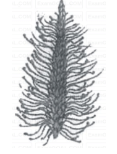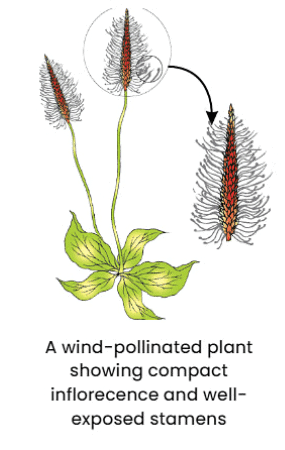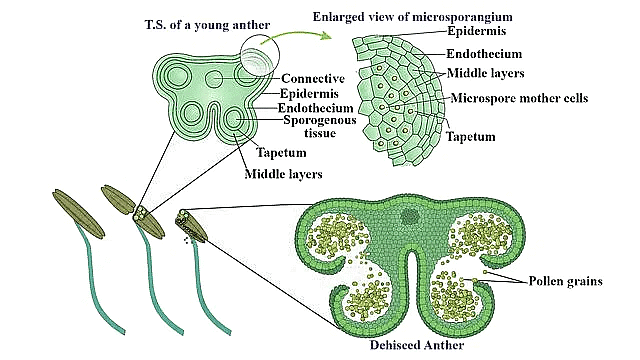Important Diagrams: Sexual Reproduction in Flowering Plants | Biology Class 12 - NEET PDF Download
Flowering plants, also called Angiosperms, use a sexual mode of reproduction. Reproduction in plants, mainly revolves around the flower, which has both the male and the female gametes. All parts of a flower aid in the process of reproduction, although some of them are sterile. Diagram based questions of this chapter is very important wrt NEET Examination. Diagrams revolve around pre-fertilization, fertilization and post-fertilization events of reproduction.
1. A Flower
The flower is considered to be a modified shoot. 4 main parts of flower:
a) Calyx: It is the outermost whorl of the flower. A single unit of the calyx is called as sepals. The function of the calyx is protection in inner floral whorls when in bud condition.
b) Corolla: Flowers are the beautiful and attractive cause of petals. Many petals unite to form a corolla. The main function of the petal is to help in pollination by attracting insects.
c) Androecium: Male reproductive whorl of the flower is called androecium. A single unit of androecium is known as the stamen. A Stamen is made up of anther, connective and filament.
d) Gynoecium: Gynoecium or carpel is the female reproductive part of the flower. The gynoecium is sometimes referred to as pistil. It consists of three parts namely stigma, style and ovary.
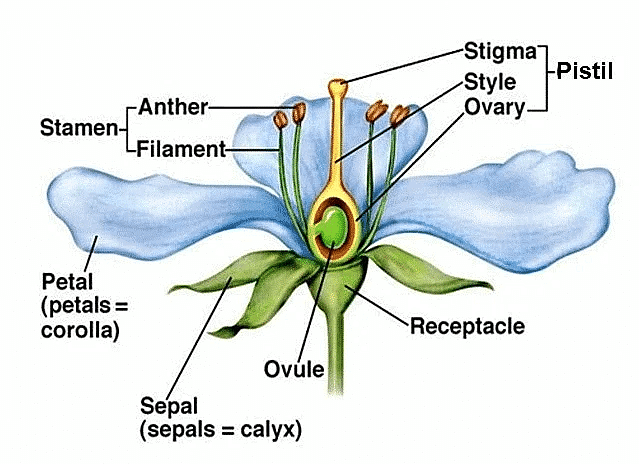 Parts of a Flower
Parts of a Flower
2. Section of a Young Anther and a Dehisced Anther
Anther is bilobed containing 4 microsporangia in angiosperms so it is known as dithecous anther. Each microsporangium contains spores that produce male gametes.
It has following layers:
- The outermost layer is known as the epidermis.
- Inner to the epidermis is the layer of endothecium.
- Inner to endothecium, there are 2-3 cell middle layers that usually disintegrate during anther maturation.
- The innermost layer is known as tapetum.
- Inner to the tapetum are the microspore mother cells which give rise to pollen grains through meiotic division.
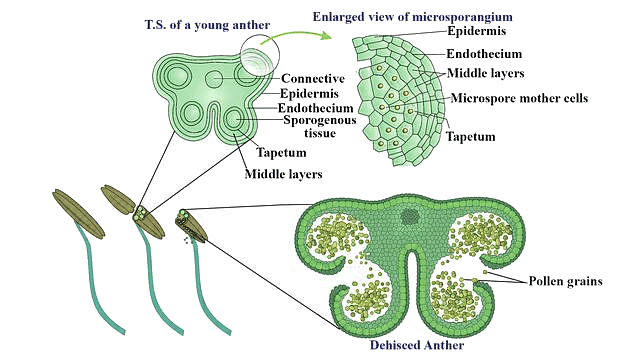 L.S of an Anther, Mature Microsporangium and dehisced anther
L.S of an Anther, Mature Microsporangium and dehisced anther
3. Formation of a Pollen Grain (Microsporogenesis)
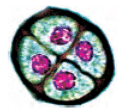 Enlarged view of pollen tetrad
Enlarged view of pollen tetrad
- The nucleus of each microspore mother cell undergoes meiosis or reduction division and gives rise to four haploid nuclei.
- This process is called microsporogenesis.
- The four nuclei are organised tetrahedrally and are shortly surrounded by cell walls.
- These are now called microspores or pollen grains.
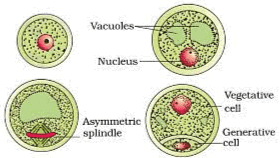 Stages of a Microspore Maturing into Pollen Grain
Stages of a Microspore Maturing into Pollen Grain
4. Structure Of Mature Pollen Grain
- The pollen grain is surrounded by two layers as: exine which forms the outer layer and intine which forms the inner layer.
- The generative cell divides to form the two male gametes.
- The vegetative cell is responsible for the providing nutrition.
- The intine layer comes out of the germ pore to form the pollen tube.
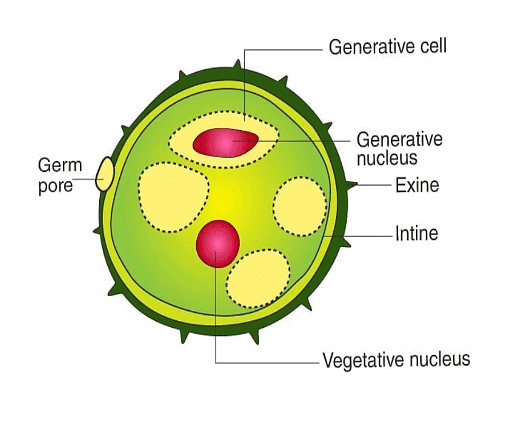 Structure of a Mature Pollen Grain
Structure of a Mature Pollen Grain
5. Types of Pistil and Anatropus Ovule
- This ovule is a completely curved or inverted structure.
- Here, the body of the ovule fuses with the funicle.
- The micropyle is found at the bottom.
- This type of ovule is seen in most monocots and dicots.
- The anatropous ovule is the most common type of ovule orientation.
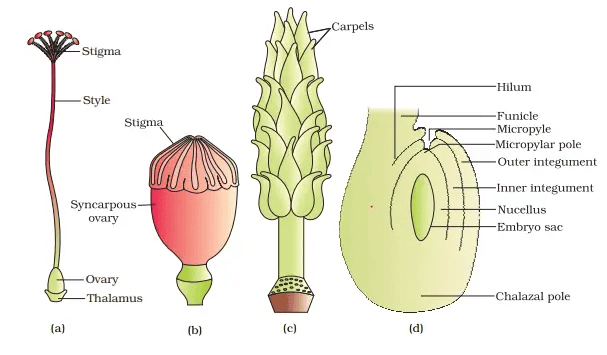 (a) A dissected flower of Hibiscus showing pistil (other floral parts have been removed); (b) Multicarpellary, syncarpous pistil of Papaver ; (c) A multicarpellary, apocarpous gynoecium of Michelia; (d) A diagrammatic view of a typical anatropous ovule
(a) A dissected flower of Hibiscus showing pistil (other floral parts have been removed); (b) Multicarpellary, syncarpous pistil of Papaver ; (c) A multicarpellary, apocarpous gynoecium of Michelia; (d) A diagrammatic view of a typical anatropous ovule
6. Formation of an Egg Cell (Megasporogenesis)
- The process of creating haploid megaspores from a diploid megaspore mother cell is known as megasporogenesis.
- A large diploid (2n) cell known as the megaspore mother cell (MMC) conducts meiotic division to produce four haploid megaspores. It also contains thick cytoplasm and a conspicuous nucleus.
- Only one of the four megaspores is viable, and the other three degenerate in the majority of blooming plants.
- The functioning megaspore develops, and as it does, its nucleus goes through mitosis and divides into eight haploid nuclei. Megagametophyte or embryo-sac are two names for the structure that results from megasporogenesis.
- Embryo Sac is the female gametophyte of a seed plant, consisting of a thin-walled sac within the nucellus which contains the egg nucleus and other nuclei that produce endosperm upon fertilisation.
- A typical mature embryo sac of Angiosperms is a 7-celled and 8-nucleate structure.
- Micropylar end: The micropyle is a small pore or opening in the outer covering of the ovule, typically located at one end (the micropylar end).
- Egg Cell (or Ovum) is situated close to the micropyle, which is the entry point for pollen tubes. The egg cell is the female gamete and fuses with a sperm cell during fertilization to form the zygote, which eventually develops into the embryo.
- Synergids are cells adjacent to the egg cell. They guide the pollen tube to the egg cell through chemical signaling, helping in the process of fertilization.
- Central Cell (or Central Nucleus) is positioned in the center of the embryo sac. It contains two nuclei, known as the polar nuclei, which are crucial for double fertilization during seed formation.
- Polar Nuclei (Polar Fusion Nuclei) are found within the central cell and are involved in double fertilization. The polar nuclei fuse with a sperm cell to form the endosperm, a nutrient-rich tissue that supports the developing embryo.
- Chalaza is the base of the embryo sac, located opposite the micropyle. It is a thickened region of tissue that connects the ovule to the ovary and helps anchor the embryo sac within the ovule.
- Antipodal cells are located at the opposite end from the micropyle.
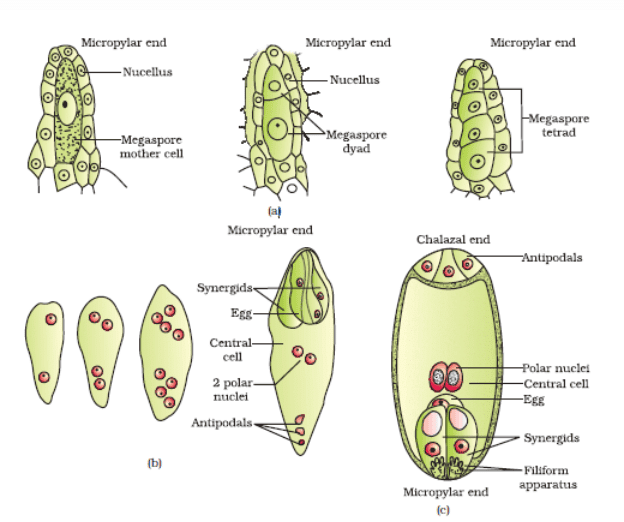
8. Pollination
The process of pollination begins when the pollen grains from the respective flowers lands on the stigma and form a pollen tube with the style length, which connects both the stigma and ovary. After the completion of the pollen tube, the pollen grain starts transmitting sperm cells from the grain to the ovary.
Pollination within flowering plants can be categorized into three main types based on the source and method of pollen transfer.
- Autogamy refers to self-pollination within the same flower, often facilitated by the close proximity of anthers and stigma, as seen in chasmogamous flowers which are open and expose their reproductive parts, making self-pollination possible. In contrast, cleistogamous flowers never open and are designed to ensure self-pollination internally without any external pollinator involvement. This adaptation guarantees seed production, especially under less favorable conditions for pollinator activity.
- Geitonogamy involves the transfer of pollen to a different flower but on the same plant, technically acting as cross-pollination but genetically equivalent to self-pollination.
- Lastly, xenogamy is the transfer of pollen to a flower on a different plant, promoting genetic diversity by mixing different pollen types.

9. Types of Pollination
- Wind and water pollination are two forms of abiotic pollination, where wind-pollinated plants like grasses and corn have light, non-sticky pollen and well-exposed stamens to facilitate dispersal through air currents.
- Water pollination is rarer and occurs in plants like Vallisneria and Zostera, which utilize water currents to transport pollen.
- Both wind and water pollinated plants typically lack bright colors and nectar since they do not need to attract animal pollinators.
- Instead, these plants often have simple flowers that efficiently use their respective mediums (air or water) for pollen transport.
- In contrast, biotic pollination involves animals such as bees, butterflies, and birds, which are attracted to colorful, nectar-producing flowers, playing a crucial role in the reproductive processes of a majority of flowering plants.
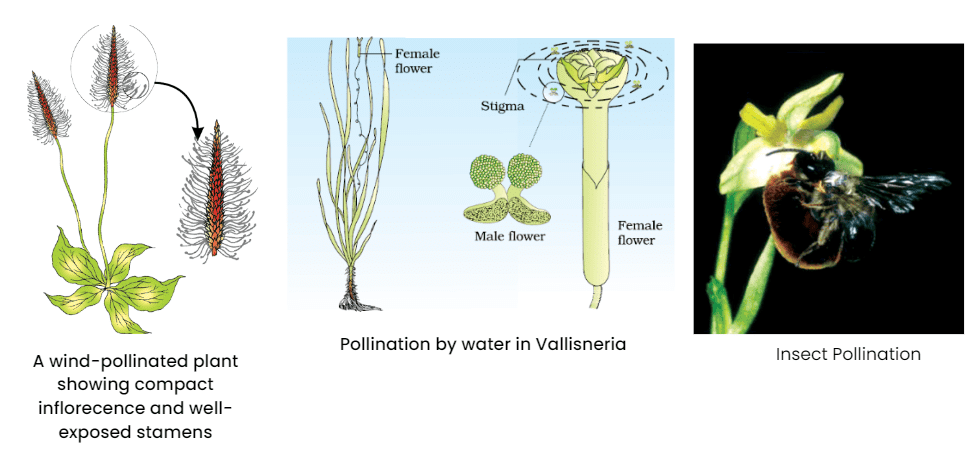 Types of Pollination : Wind, Water and Insect
Types of Pollination : Wind, Water and Insect
9. Pollen Pistil Interaction
- Pollen-pistil interaction is a critical process in plant reproduction where the pistil recognizes and either accepts or rejects pollen based on compatibility.
- When compatible pollen lands on the stigma, it germinates, forming a pollen tube that navigates through the pistil to reach the ovary and subsequently the ovule, guided by chemical signals and structures like the filiform apparatus.
- This tube carries the male gametes, which fertilize the egg within the ovule. Conversely, incompatible pollen is rejected, preventing germination or pollen tube growth.
- This selective interaction ensures genetic compatibility and viability of offspring, playing a vital role in successful plant breeding and hybridization.
 (a) Pollen grains germinating on the stigma; (b) Pollen tubes growing through the style
(a) Pollen grains germinating on the stigma; (b) Pollen tubes growing through the style
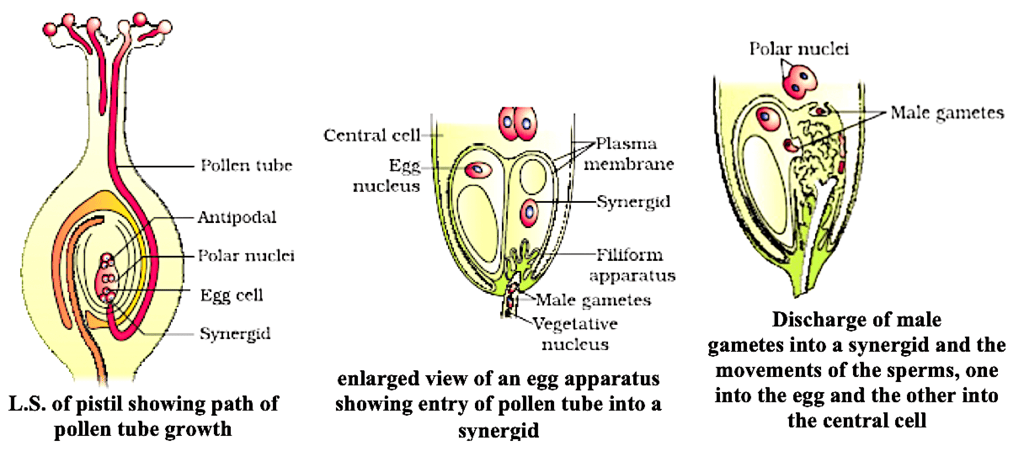 Pollen Pistil Interaction
Pollen Pistil Interaction
10. Double Fertilization
- Double fertilization is a chief trait of flowering plants.
- Double fertilization is a complex process where out of two sperm cells, one fuses with the egg cell and the other fuses with two polar nuclei which result in a diploid (2n) zygote and a triploid (3n) primaryendosperm nucleus (PEN) respectively.
- Double fertilization provides stimulus to the plant resulting in the ovarian development to fruits and the development of ovules into the seed.
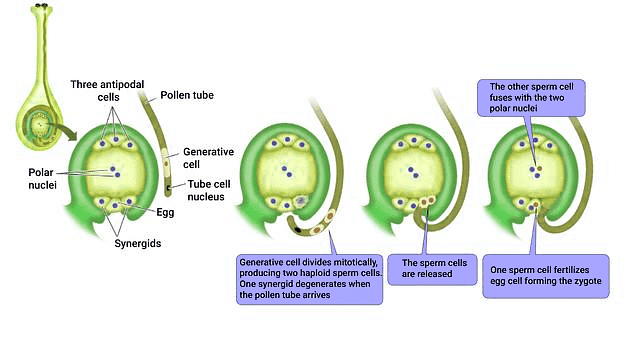 Process of Double Fertilization
Process of Double Fertilization
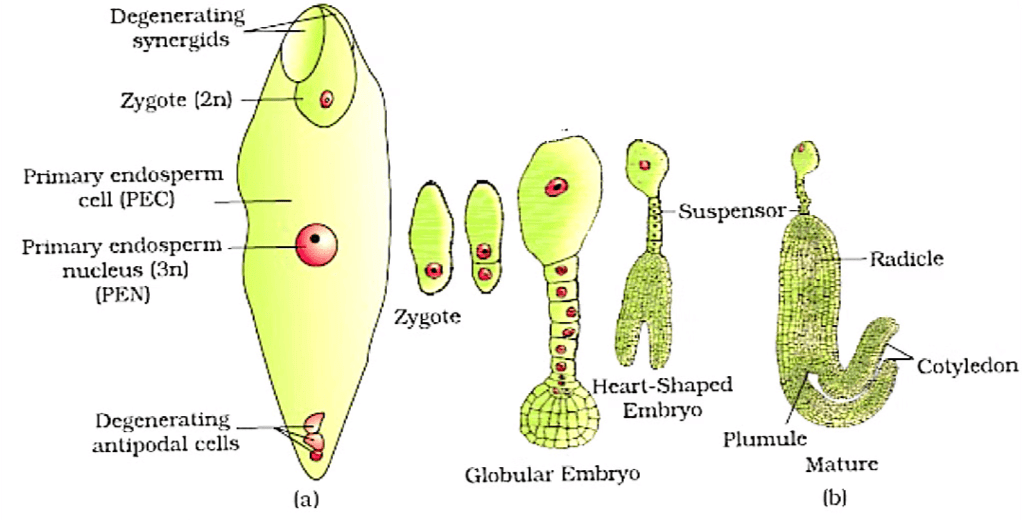
11. Types and Development of Embryo
- Embryo development in plants starts at the micropylar end of the embryo sac where the zygote is located, with division occurring after the formation of endosperm for nutritional support.
- In dicotyledons, the embryo progresses through stages from a proembryo to a mature form featuring an embryonal axis, two cotyledons, an epicotyl above the cotyledons leading to the plumule, and a hypocotyl below leading to the radicle protected by a root cap.
- Monocotyledons, on the other hand, typically develop a single cotyledon known as the scutellum, with the embryonal axis supporting a radicle encased in a coleorrhiza and an epicotyl topped by a coleoptile, which contains the shoot apex and leaf primordia. These structures support the initial stages of plant growth following germination.
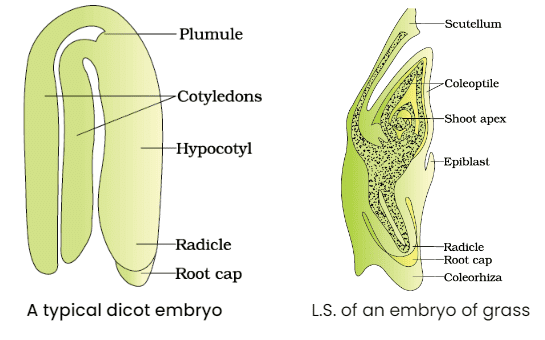 Types of Embryo
Types of Embryo
12. Types of Seeds and Fruits
In angiosperms, seeds are the end product of sexual reproduction, forming within fruits and consisting of a seed coat, cotyledons, and an embryo axis. Cotyledons store food, aiding early growth, while seeds can be albuminous (with retained endosperm) or non-albuminous (endosperm consumed during development). Seed development involves hardening of the ovule's integuments into a protective coat, with a micropyle that allows water and oxygen to enter during germination. As the seed matures, it dries and may enter dormancy until germination conditions are favourable.
The ovary of the flower transforms into fruit, which can be fleshy or dry and plays a crucial role in seed dispersal. Some plants, like bananas, can produce fruit without fertilization, a condition known as parthenocarpy, often enhanced by growth hormones for seedless fruit production. This process coincides with the degeneration of other floral parts, except in some cases where structures like the thalamus also contribute, leading to what are known as false fruits.
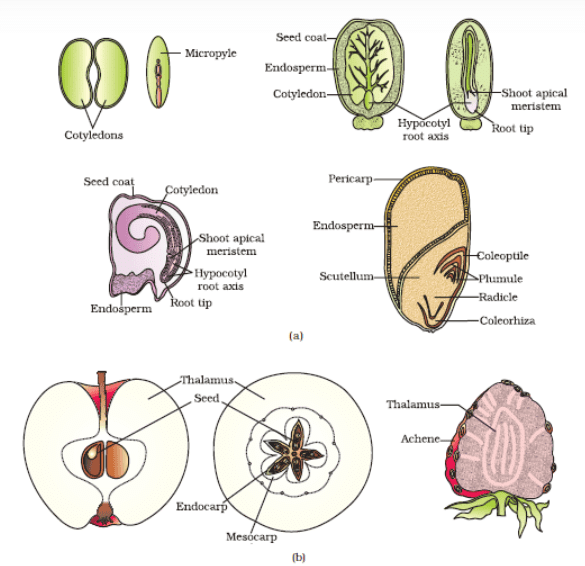
Diagram Based Previous Year Questions - NEET
Q1: Identify the correct description about the given figure : [NEET 2024]
(a) Wind pollinated plant inflorescence showing flowers with well exposed stamens.
(b) Water pollinated flowers showing stamens with mucilaginous covering.
(c) Cleistogamous flowers showing autogamy.
(d) Compact inflorescence showing complete autogamyAns: (a)
The given diagram shows a wind pollinated plant showing compact inflorescence and well exposed stamens.
Stamens are exposed so complete autogamy does not occur.
Q 2: What is the function of the tapetum in the anther?
a) Production of pollen grains
b) Protection of microspores
c) Nutrient supply to developing pollen grains
d) Attachment of the anther to the filament
Ans: c) Nutrient supply to developing pollen grains.
Solution.
- The tapetum is a specialized layer of cells present within the anther of flowering plants.
- It surrounds the developing microsporangia, which are the pollen sacs within the anther.
- The tapetum has an important role in supporting the development of pollen grains.
Q 3: The region of the ovule where the integuments join is known as_______.
a) Micropyle
b) Hilum
c) Chalaza
d) Funicle
Ans: c) ChalazaSolution.
Structure of Anatropous Ovule
- The region of the ovule where the integuments join is known as the chalaza.
- The chalaza is located at the base of the ovule, opposite the micropyle.
Q4: A typical angiosperm embryo sac at maturity is:
(a) 7-nucleate and 7-celled
(b) 8-nucleate and 8-celled
(c) 8-nucleate and 7-celled
(d) 7-nucleate and 8-celled
Ans. c)
Solution.
Structure of Embryo Sac
- The mature embryo sac has three cells called antipodals at the chalazal end and three cells at micropylar end constituting the egg apparatus.
- Each of these cells consists one nuclei.
- The egg apparatus consists of two synergids and one egg cell.
- There is one large central cell present which consists of two polar nuclei.
- Hence embryo sac has 7 cells and 8 nuclei.
Some Important Terms
- Microsporogenesis: The process of formation of microspores from a pollen mother cell (PMC) through meiosis is called microsporogenesis.
- Pollen Grains: As the anthers mature and dehydrate, the microspores dissociate from each other and develop into pollen grains. The pollen grains represent the male gametophytes.
- Exine: Pollen grains are generally spherical measuring about 25-50 micrometers in diameter. It has a prominent two-layered wall. The hard outer layer called the exine is made up of sporopollenin which is one of the most resistant organic material known.
- Germ Pore: Pollen grain exine has prominent apertures called germ pores where sporopollenin is absent.
- Intine: The inner wall of the pollen grain is called the intine.
- Vegetative Cell: When the pollen grain is mature it contains two cells, the vegetative cell and generative cell. The vegetative cell is bigger, has abundant food reserve and a large irregularly shaped nucleus.
- Generative Cell: The generative cell is small and floats in the cytoplasm of the vegetative cell.
- Stigma, style & ovary: The stigma serves as a landing platform for pollen grains. The style is the elongated slender part beneath the stigma. The basal bulged part of the pistil is the ovary.
- Ovule: The ovule is a small structure attached to the placenta by means of a stalk called funicle.
- Integuments: Each ovule has one or two protective envelopes called integuments.
- Nucellus: Enclosed within the integuments is a mass of cells called the nucellus.
- Megasporogenesis: The process of formation of megaspores from the megaspore mother cell is called megasporogenesis.
- Antipodals: Three cells are at the chalazal end and are called the antipodals.
- Pollination: Transfer of pollen grains (shed from the anther) to the stigma of a pistil is termed as pollination.
- Autogamy: In this type, pollination is achieved within the same flower. Transfer of pollen grains from the anther to the stigma of the same flower.
- Chasmogamous flowers: These are similar to flowers of other species with exposed anthers and stigma.
- Cleistogamous flowers: Cleistogamous flowers which do not open at all.
- Geitonogamy: Transfer of pollen grains from the anther to the stigma of another flower of the same plant.
- Xenogamy: Transfer of pollen grains from anther to the stigma of a different plant.
- Emasculation: If the female parent bears bisexual flowers, removal of anthers from the flower bud before the anther dehisces using a pair of forceps is necessary. This step is referred to as emasculation.
- Bagging: Emasculated flowers have to be covered with a bag of suitable size, generally made up of butter paper, to prevent contamination of its stigma with unwanted pollen. This process is called bagging.
- Zygote: Male gametes moves towards the egg cell and fuses with its nucleus thus completing the syngamy. This results in the formation of a diploid cell, the zygote.
- Double Fertilisation: Two types of fusions, syngamy and triple fusion take place in an embryo sac the phenomenon is termed double fertilisation.
- Scutellum: Embryos of monocotyledons possess only one cotyledon. In the grass family the cotyledon is called scutellum.
- Non albuminous: Non albuminous seeds have no residual endosperm as it is completely consumed during embryo development.
- Albuminous seeds: Albuminous seeds retain a part of endosperm as it is not completely used up during embryo development.
- Pericarp: The wall of the ovary develops into the wall of fruit called pericarp.
- False fruits: In most plants, by the time the fruit develops from the ovary, other floral parts degenerate and fall off. However, in a few species such as apple, strawberry, cashew, etc., the thalamus also contributes to fruit formation. Such fruits are called false fruits.
- True Fruits: Most fruits however develop only from the ovary and are called true fruits.
- Parthenocarpic fruits: In most of the species, fruits are the results of fertilisation, there are a few species in which fruits develop without fertilisation. Such fruits are called parthenocarpic fruits.
- Apomixis: A few flowering plants such as some species of Asteraceae and grasses, have evolved a special mechanism, to produce seeds without fertilisation, called apomixis.
- Polyembryony: Occurrence of more than one embryo in a seed is referred to as polyembryony.
|
59 videos|290 docs|168 tests
|
FAQs on Important Diagrams: Sexual Reproduction in Flowering Plants - Biology Class 12 - NEET
| 1. What are the main parts of a flower involved in sexual reproduction? |  |
| 2. What is microsporogenesis and its significance in the formation of pollen grains? |  |
| 3. How does pollination occur in flowering plants? |  |
| 4. What is double fertilization, and why is it important in flowering plants? |  |
| 5. What is the structure of an anatropous ovule, and how does it relate to fertilization? |  |


